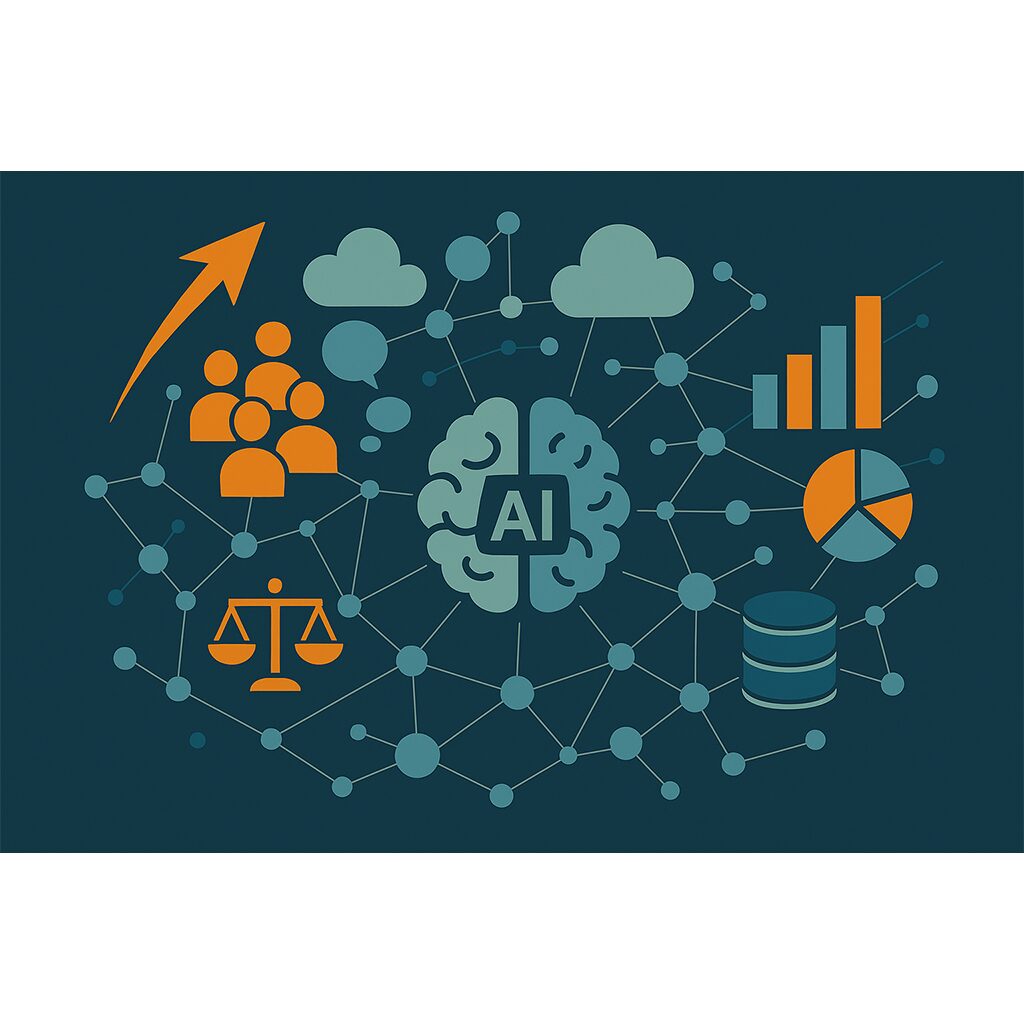Executive Summary
Artificial Intelligence (AI) is no longer a distant promise—it is here, reshaping industries worldwide. For Alaska’s businesses, 2025 marks a pivotal year to move from curiosity to action. National and global competitors are investing heavily in AI to cut costs, improve decision-making, and unlock new growth. Waiting too long risks leaving Alaskan businesses behind.
At the same time, AI has become more accessible than ever through cloud-native platforms and “copilot” applications built with smaller organizations in mind. With the right plan, even modestly sized firms in Alaska can leapfrog larger competitors still mired in complexity.
This white paper offers a pragmatic roadmap—five clear stages that help organizations adopt AI responsibly, safely, and strategically. It highlights the challenges to address and provides a compass for ethical adoption.
Pango Technology, an Anchorage-based IT consulting firm, has deep local roots and expertise in helping Alaskan organizations implement transformative technologies. Our role is not to hype AI—it is to guide Alaskan leaders through the real-world steps of adoption so they can seize the 2025 opportunity with confidence.
Note: This roadmap draws inspiration from the Microsoft SMB Copilot Success Kit, which we have adapted to reflect the realities of Alaska’s business environment.
Why AI? Why Now?
National & Global Trends
Across the globe, businesses are rapidly weaving AI into everyday operations. From streamlining supply chains to automating paperwork, AI has shifted from “experimental” to “expected.” Early adopters are already reporting efficiency gains of 20–30%. In the U.S., competitive pressure is growing—firms that fail to adopt AI risk being left behind, unable to match the productivity or insight of their AI-powered peers.
The Alaska Angle
Alaska presents a unique business environment: vast geography, smaller market sizes, and a tradition of resourcefulness. For many Alaskan firms, scale has always been a barrier to technology adoption. But cloud-native AI tools flip that dynamic. Suddenly, small and mid-sized organizations can access the same capabilities as national giants—without building massive infrastructure.
This is a chance for Alaskan businesses to leapfrog. Imagine an oilfield services company that can automate field reporting, or a healthcare provider that uses AI-assisted scheduling to maximize staff efficiency. The payoff is not abstract; it is practical, measurable, and increasingly necessary.
SMBs at Risk
Still, the opportunity comes with risk. Rushing in without a plan—buying tools without governance or training—can waste money and erode trust. On the other hand, small and mid-sized businesses (SMBs) that wait too long risk losing ground to competitors who harness AI early. The sweet spot is a structured roadmap, designed for Alaska’s realities.
Key Challenges to Address
Adopting AI is not about flipping a switch. Successful adoption requires addressing four critical challenges upfront:
- Data Quality and Governance: AI runs on data. If the data is incomplete, inconsistent, or unsecured, results will be unreliable at best—and risky at worst.
- Change Resistance and User Readiness: Employees may fear AI will replace them, or simply resist changing established workflows. Without trust and training, adoption will stall.
- Ethical & Legal Considerations: Privacy, bias, and accountability are front-and-center. Especially in regulated sectors (healthcare, government), organizations must set policies that ensure AI is transparent and fair.
- Limited IT Resources & Expertise: Many firms do not have internal AI experts on staff. Partnering wisely is essential to avoid overreach or missteps.
How the Roadmap Addresses These Challenges
The challenges outlined above are real, but they are not insurmountable. Each stage of the roadmap has been designed to meet these concerns directly:
- Data Quality & Governance: Strengthened in Stage 1 through readiness assessments, acceptable use policies, and data frameworks.
- Change Resistance & User Readiness: Tackled in Stage 2 with light-touch training, pilot teams, and forums for sharing lessons learned.
- Ethical & Legal Considerations: Addressed in Stage 1 with policy, reinforced in Stage 4 through governance, and expanded in the dedicated Ethics section.
- Limited IT Resources & Expertise: Managed through gradual scaling in Stages 3 and 4, with communities of practice and a thoughtful pace of adoption.
This mapping ensures the roadmap is not theoretical; it is purpose-built to help Alaskan firms move past these barriers and adopt AI with confidence.
The 5-Stage Roadmap to AI Adoption
Adopting AI successfully is not a single leap but a steady climb. Each stage builds on the last, so that organizations move from cautious preparation to confident, ongoing use. The following roadmap is designed to guide Alaskan firms step by step.

Stage 1: Get Ready (Foundations)
Before an organization can experiment with AI, it needs a sturdy foundation. Leaders must align on a shared vision and set clear guardrails for what AI will and will not be used for. A key early deliverable is the creation of an Acceptable Use Policy—something that defines employee responsibilities, outlines boundaries on data use, and ensures compliance with privacy requirements. Alongside policy, an AI readiness assessment can help identify strengths and gaps, from technical prerequisites to organizational culture. Finally, data governance and security frameworks should be reinforced, so that when AI tools begin to arrive, they are working on clean, consistent, and well‑protected information.
Stage 2: Start Small (Pilot Projects)
With the groundwork laid, the next step is to test the waters. This pilot stage is the time to identify a handful of teams ready to give it a try. These early adopters are not expected to solve every business challenge with AI; rather, they explore and provide quick wins with visible benefits. Examples might include meeting summaries, automated document drafting, or improved customer support interactions.[1]
Because adoption is as much about people as it is about technology, training at this stage should be light‑touch and accessible. Short sessions, demos, and peer‑to‑peer sharing help employees get comfortable without being overwhelmed. Equally important is creating forums where teams can exchange lessons learned, celebrate small successes, and surface challenges. These conversations build momentum and help shape a culture that sees AI as a helpful tool rather than a disruptive threat.
Stage 3: Find the Big Idea
Pilots generate quick wins, but their real value is in pointing to bigger possibilities. Leaders and teams should sift through pilot results and participant ideas and ask: what could this mean at scale? Sometimes the best opportunities reveal themselves in unexpected corners—a routine reporting task becomes the seed for a company‑wide data strategy, or an internal chatbot evolves into a new way of serving customers. The goal is to balance bottom‑up discoveries with top‑down strategic bets. To make progress tangible, organizations can rely on tools like a Copilot Dashboard that track adoption, satisfaction, and business outcomes. These measures keep the focus on value, not just novelty.
Stage 4: Scale Safely
Once the big idea emerges, the temptation is to rush forward. But scaling AI too quickly is risky. This stage is about disciplined expansion. Building a community of practice across departments ensures knowledge is shared and mistakes are not repeated. Rather than rolling out tools everywhere at once, organizations can extend AI gradually into functions like HR, finance, or logistics, tailoring solutions to each department’s needs. As confidence grows, AI agents (that is to say, small AI applications) can be introduced, but always with clear governance. The mantra here is simple: scale, but scale safely.
Stage 5: Continuous Learning
Even after AI is in wide use, the journey continues. Adoption is not a finish line—it is an ongoing cycle of learning, refinement, and adaptation. Feedback loops should remain open, giving teams safe spaces to share what works, what does not, and what should be tried next. Some use cases will prove valuable and deserve continued investment, while others may fade away as business priorities change.
Governance also matures here. Data quality, security controls, and licensing agreements should be reviewed regularly—quarterly is a healthy cadence—to avoid drift and ensure compliance. Just as important is celebrating wins. Recognizing successes, whether big or small, sustains energy across the organization. In Alaska, where resilience and adaptability are part of the business culture, this habit of continuous learning ensures AI remains a living, evolving asset rather than a one‑time initiative.
Ethical AI Adoption: A Practical Compass
There is a whole series of white papers and a shelf of books to be written about the ethical use of AI. We do not have that kind of space here, but it would be remiss to not mention:
- Fairness: Ensure systems do not amplify bias.
- Transparency: Communicate clearly how AI tools are used.
- Risk Mitigation: Put guardrails in place for privacy, data security, and compliance.
Policies, employee training, and governance committees are not bureaucracy—they are trust-builders. They reassure staff, customers, and regulators that AI is being deployed responsibly, not recklessly.
Final Thoughts: Seizing the 2025 Opportunity
AI is moving quickly, but do not let that scare you into indecision. The key is to start small, smart, and now. By following a structured roadmap, Alaskan organizations can reduce risk, build internal confidence, and position themselves for competitive advantage.
2025 does not have to be the year you play catch-up—it can be the year you jump ahead with practical, ethical AI adoption.
Pango Technology has helped organizations across industries navigate technology change and modernization, and now we are bringing that experience to guide firms in their AI journey. As a local partner, we understand both the technological terrain and Alaska’s business realities.
Let’s explore what AI could mean for your business—starting with a simple readiness session.
Pango Technology
http://www.pangotechnology.com/
907 – 868 – 8092
[1] Please see “Top 10 things to try first with Microsoft 365 Copilot Microsoft” for a handy starter kit. You can find it at https://www.microsoft.com/en-us/microsoft-365-copilot/copilot-top-10-things-to-try-first.


